Erica glandulosa subsp. glandulosa
Erica glandulosa subsp. glandulosa Thunb.
Family: Ericaceae
Common names: glandulous heath
Introduction
Erica glandulosa is one of the hardiest and most dependable of the Cape heaths in mild temperate and Mediterranean style gardens.

Description
Description
Erica glandulosa is a widespread species and shows considerable variation over its distribution range. This has prompted taxonomists to group it into four subspecies. Erica glandulosa subsp. glandulosa is the best known and most widely distributed form and has been grown in gardens for many a year. It is a sturdy, medium-sized, single- to multi-stemmed, bushy shrub growing up to 1,5 m tall. Except for the flowers, it is covered with tiny glandular hairs, which give it a mildly sticky feel. The leaves are grouped on short side branches on sturdy stems giving the shrub an overall, thickly leafy appearance.
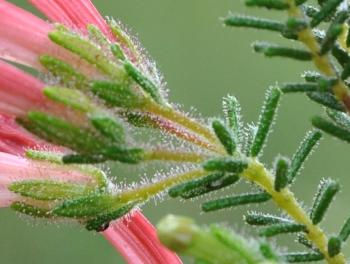
The flowers are attractive, curved and tubular, between 18 and 26 mm long. They are shiny and semi-translucent, normally pink to orange, but yellow-flowered forms are also found.
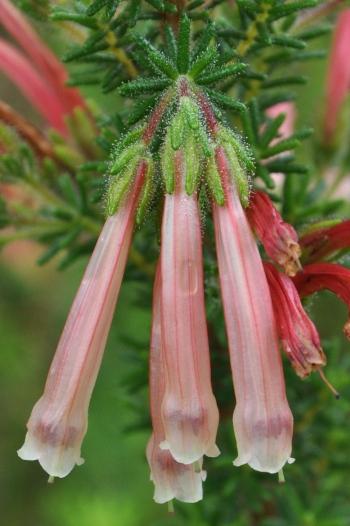
Conservation Status
Status
Erica glandulosa subsp. glandulosa is widespread and commonly found in nature reserves and conserved areas along the mountains and coastal plains of the southern and western Eastern Cape and into the Western Cape and is not regarded as threatened. It is listed as Least Concern (LC) in the Red List of South African Plants.
Distribution and habitat
Distribution description
Erica glandulosa subsp. glandulosa is widely distributed from the eastern Langeberg, along the southern Cape mountains and lowlands, to Port Elizabeth. It is also found inland to the eastern Swartberg range. A lovely yellow-flowered form occurs on the northern slopes of the Outeniqua Mountains. A beautiful pink-flowered form is found on the fynbos lowlands between Humansdorp and Port Elizabeth where it is often seen flowering along the N2 freeway.
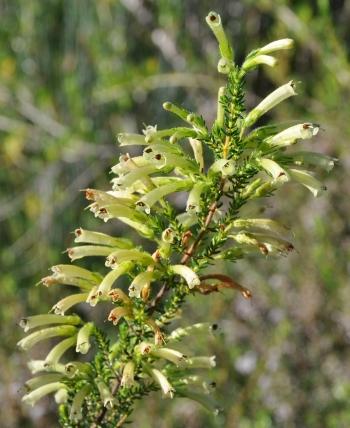
Derivation of name and historical aspects
History
Erica glandulosa gets its name from the Latin glandulosus because it is covered with thousands of tiny glandular hairs.
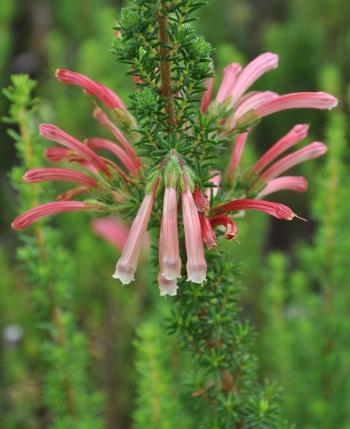
Ecology
Ecology
Erica glandulosa is found in warm sunny positions on mountain slopes and in the lowlands. It grows on acidic sands derived from quartzite rock and is adapted to poor, well-drained soils. It is a hardy species that survives long, hot summers. It is a reseeding species, meaning that it reproduces from seed and does not re-sprout after fire. It produces copious quantities of seed and germinates easily after fire or where old plants have been cleared away. Its tubular flowers attract sunbirds that seek its nectar, and in dipping into the flower tube disturb the anthers which deposit pollen onto the beak. Plants are pollinated as the birds move from flower to flower.
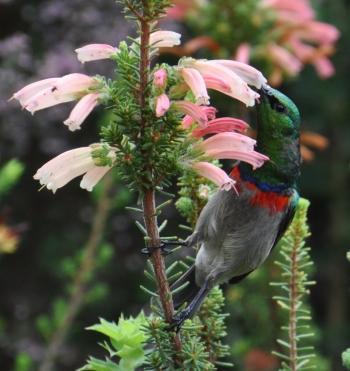
Uses
Use
Erica glandulosa is a very showy species and flowers almost throughout the year. It is recommended as a strong-growing, reliable garden plant and is easy to maintain in average Mediterranean conditions if soils are acidic and will also grow well as a large pot plant. This species is ideal for warm, sunny gardens and is quite salt-tolerant and therefore a good plant for a coastal garden, providing that the soils are acidic.
Growing Erica glandulosa subsp. glandulosa
Grow
Erica glandulosa is easily grown from fresh seed which should be sown in late summer or autumn. Germination is greatly enhanced by the application of smoke which mimics the conditions in nature. Seed is sown onto a well-drained, slightly acidic growing medium consisting of a combination of river sand and well decomposed pine bark in roughly equal proportions. Seed germinates in about six weeks, emerging as tiny, delicate plantlets that must be lightly watered with a watering can. Let the seedlings grow to about 10 mm tall before pricking them out into small individual pots. Young seedlings are encouraged to grow by feeding them every week with a diluted organic fertilizer. Seedlings grow slowly and will only be big enough after twelve months when they may be planted into the garden. It is advisable to plant out during the cooler autumn or early winter months to allow the plants to establish before the onset of summer.
Erica glandulosa is easily rooted from cuttings in autumn or spring, in multi-trays on heated benches under mist spray. Select small tip- or heel cuttings about 20-30 mm long, taking thin wood from the previous season's growth. Heel cuttings are preferred where a short side shoot is removed from the stem. The base of the cutting is treated with a rooting hormone for semi-hardwood cuttings which are then placed into a rooting medium of 50 : 50 fine-milled bark and polystyrene or perlite pellets.
It grows well near the sea as long as it is in acidic soils and protected from direct exposure to strong salt-laden winds. A good watering once a week during summer months is recommended. This species should provide a good show for at least 10 years and probably many more after that.
Erica glandulosa can be grown in a large container, providing that the correct, well-draining growing medium is provided. Fynbos planting medium is made up of a combination of equal parts composted pine bark or pine needles and river sand. A little (20%) loam may also be added. It is a woody species, so regular pruning is recommended to keep the plants well branched and compact. Plants that are pruned are more presentable, last longer and produce more flowers.
Erica plants are adapted to living in poor soils, but, for best results, should be regularly fed with diluted organic liquid or small amounts of organic pellet fertilizers that are low in phosphorus.
References
- Goldblatt, P. & Manning, J.C. 2000. Cape plants. A conspectus of the Cape flora of South Africa. Strelitzia 9. National Botanical Institute, Pretoria and Missouri Botanical Garden.
- Schumann, D. (Dolf), Kirsten, G. (Gerard) & Oliver, E.G.H. 1992. Ericas of South Africa . Fernwood Press, Vlaeberg, Cape Town. http://www.sanbi.org/biodiversity/reddata.htm
Credits
Anthony Hitchcock
Kirstenbosch National Botanical Garden
May 2013
Plant Attributes:
Plant Type: Shrub
SA Distribution: Eastern Cape, Western Cape
Soil type: Sandy, Loam
Flowering season: Spring, Autumn, Winter
PH: Acid
Flower colour: Pink, Cream, Yellow, Orange
Aspect: Full Sun
Gardening skill: Easy
Special Features:
Horticultural zones








Rate this article
Article well written and informative
Rate this plant
Is this an interesting plant?
Login to add your Comment
Back to topNot registered yet? Click here to register.